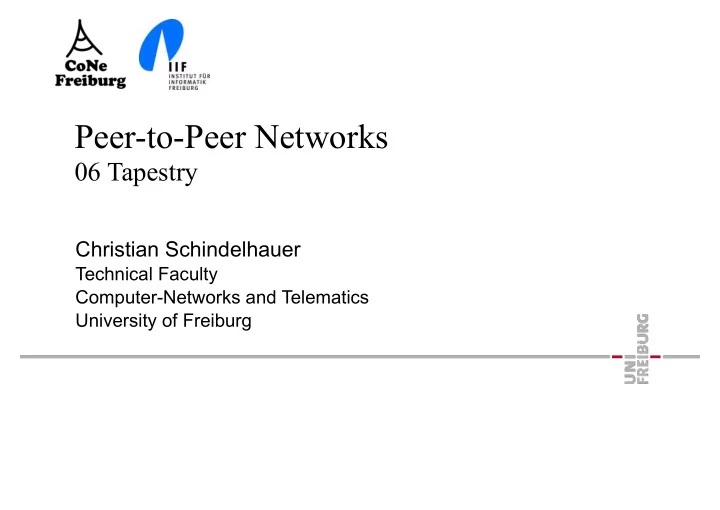

Peer-to-Peer Networks 06 Tapestry Christian Schindelhauer Technical Faculty Computer-Networks and Telematics University of Freiburg
Tapestry § Objects and Peers are identified by - Objekt-IDs (Globally Unique Identifiers GUIDs) and - Peer-IDs § IDs - are computed by hash functions • like CAN or Chord - are strings on basis B • B=16 (hexadecimal system) 2
Neighborhood of a Peer (1) § Every peer A maintains for each prefix x of the Peer-ID - if a link to another peer sharing this Prefix x - i.e. peer with ID B=xy has a neighbor A, if xy´=A for some y, y´ § Links sorted according levels - the level denotes the length of the common prefix - Level L = |x|+1 3
Neighborhood Set (2) § For each prefix x and all letters j of the peer with ID A - establish a link to a node with prefix x j within the neighboorhood set § Peer with Node-ID A has b |A| neighborhood sets § The neighborhood set of contains all nodes with prefix s j - Nodes of this set are denoted by (x,j) 4
Example of Neighborhood Sets Neighborhood set of node 4221 Level 4 Level 3 Level 2 Level 1 j=0 4220 4220 420? 420? 40?? 40?? 0??? 0??? j=1 4221 4221 421? 421? 41?? 41?? 1??? 1??? . 4222 4222 422? 422? 42?? 42?? 2??? 2??? . 4223 4223 423? 423? 43?? 43?? 3??? 3??? . 4224 4224 424? 424? 44?? 44?? 4??? 4??? . . 4225 4225 425? 425? 45?? 45?? 5??? 5??? . 4226 4226 426? 426? 46?? 46?? 6??? 6??? j=7 4227 4227 427? 427? 47?? 47?? 7??? 7??? 5
Links § For each neighborhood set at most k Links are maintained § Note: - some neighborhood sets are empty 6
Properties of Neighborhood Sets § Consistency - If für any A • then there are no (x,j) peers in the network • this is called a hole in the routing table of level |x|+1 with letter j § Network is always connected - Routing can be done by following the letters of the ID b 1 b 2 … b n 1st hop to node A 1 2nd hop to node A 2 3rd hop to node A 3 … 7
Locality § Metric - e.g. given by the latency between nodes § Primary node of a neighborhood set - The closest node (according to the metric) in the neighborhood set of A is called the primary node § Secondary node - the second closest node in the neighborhood set § Routing table - has primary and secondary node of the neighborhood table 8
Root Node § Object with ID Y should stored by a so-called Root Node with this ID § If this ID does not exist then a deterministic choice computes the next best choice sharing the greatest common prefix 9
Surrogate Routing § Surrogate Routing - compute a surrogate (replacement root node) - If (x,j) is a hole, then choose (x,j+1),(x,j+2), … until a node is found - Continue search in the next higher level 10
Example: Surrogate Routing § Lookup of 4666 by peer 2716 2716 Level 1, j=4 4233 Level 2, j=6 does not exist, next link j=8 4899 Level 3, j=6 4860 Peer 4860 has no level 4 neighbors => end of search 11
Publishing Objects § Peers offering an object (storage servers) - send message to the root node § All nodes along the search path store object pointers to the storage server 12
Lookup § Choose the root node of Y § Send a message to this node - using primary nodes § Abort search if an object link has been found - then send message to the storage server 13
Fault Tolerance § Copies of object IDs - use different hash functions for multiple root nodes for objects - failed searches can be repeated with different root nodes § Soft State Pointer - links of objects are erased after a designated time - storage servers have to republish • prevents dead links • new peers receive fresh information 14
Surrogate Routing § Theorem - Routing in Tapestry needs O(log n) hops with high probability 15
Adding Peers § Perform lookup in the network for the own ID - every message is acknowledged - send message to all neighbors with fitting prefix, • Acknowledged Multicast Algorithm § Copy neighborhood tables of surrogate peer § Contact peers with holes in the routing tables - so they can add the entry - for this perform multicast algorithm for finding such peers 16
Leaving of Peers § Peer A notices that peer B has left § Erase B from routing table Root - Problem holes in the network can B occur § Solution: Acknowledged A Multicast Algorithm § Republish all object with next hop to root peer B 17
Pastry versus Tapestry § Both use the same routing principle - Plaxton, Rajamaran und Richa - Generalization of routing on the hyper-cube § Tapestry - is not completely self-organizing - takes care of the consistency of routing table - is analytically understood and has provable performance § Pastry - Heuristic methods to take care of leaving peers - More practical (less messages) - Leaf-sets provide also robustness 18
Peer-to-Peer Networks 06 Tapestry Christian Schindelhauer Technical Faculty Computer-Networks and Telematics University of Freiburg
Recommend
More recommend